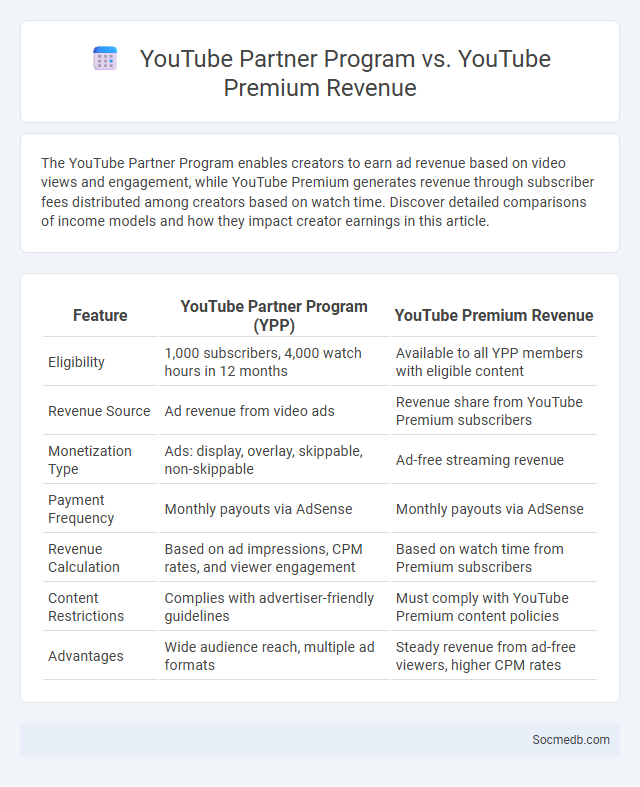
Photo illustration: YouTube Partner Program vs YouTube Premium Revenue
The YouTube Partner Program enables creators to earn ad revenue based on video views and engagement, while YouTube Premium generates revenue through subscriber fees distributed among creators based on watch time. Discover detailed comparisons of income models and how they impact creator earnings in this article.
Table of Comparison
| Feature | YouTube Partner Program (YPP) | YouTube Premium Revenue |
|---|---|---|
| Eligibility | 1,000 subscribers, 4,000 watch hours in 12 months | Available to all YPP members with eligible content |
| Revenue Source | Ad revenue from video ads | Revenue share from YouTube Premium subscribers |
| Monetization Type | Ads: display, overlay, skippable, non-skippable | Ad-free streaming revenue |
| Payment Frequency | Monthly payouts via AdSense | Monthly payouts via AdSense |
| Revenue Calculation | Based on ad impressions, CPM rates, and viewer engagement | Based on watch time from Premium subscribers |
| Content Restrictions | Complies with advertiser-friendly guidelines | Must comply with YouTube Premium content policies |
| Advantages | Wide audience reach, multiple ad formats | Steady revenue from ad-free viewers, higher CPM rates |
Introduction: Understanding YouTube’s Monetization Models
YouTube's monetization models offer diverse revenue streams for content creators, including ad revenue, channel memberships, Super Chats, and merchandise shelf integration. Understanding these monetization options empowers you to maximize earnings by tailoring content to audience engagement and platform algorithms. Leveraging YouTube's Partner Program unlocks further monetization potential, requiring adherence to eligibility criteria like 1,000 subscribers and 4,000 watch hours.
What is the YouTube Partner Program (YPP)?
The YouTube Partner Program (YPP) enables content creators to monetize their videos through ads, channel memberships, and merchandise shelves, providing multiple revenue streams. Eligibility requires at least 1,000 subscribers and 4,000 watch hours in the past 12 months, ensuring active and engaged audiences. YPP offers access to advanced analytics and audience insights, helping creators optimize content and grow their channels effectively.
What is YouTube Premium Revenue?
YouTube Premium revenue is generated from subscribers who pay a monthly fee for ad-free content, offline viewing, and access to YouTube Originals. This revenue stream supports content creators through a revenue-sharing model based on watch time from Premium subscribers. YouTube Premium diversifies YouTube's income beyond traditional advertising by providing a steady subscription-based profit source.
Eligibility Requirements for YPP and YouTube Premium
To qualify for the YouTube Partner Program (YPP), channels must have at least 1,000 subscribers and 4,000 valid public watch hours in the past 12 months, ensuring content meets YouTube's community guidelines and monetization policies. YouTube Premium membership offers ad-free viewing, background play, and access to exclusive content, requiring a monthly subscription fee for eligibility. Both YPP and YouTube Premium require adherence to YouTube's terms of service, with YPP creators undergoing a review process for channel monetization approval.
How Revenue is Generated: Ads vs Subscriptions
Social media platforms primarily generate revenue through targeted advertising, leveraging user data to deliver personalized ads that drive higher engagement and advertiser spend. Subscription models, such as premium memberships or ad-free experiences, provide an alternative income stream but currently represent a smaller portion of overall revenue compared to ad sales. The dominance of ad revenue reflects the extensive reach and data-driven capabilities of platforms like Facebook, Instagram, and Twitter, while emerging subscription services aim to diversify and stabilize income sources.
Revenue Share: Partner Program vs YouTube Premium
Social media platforms generate significant income through various revenue share models, with Partner Programs typically offering creators a percentage of ad revenue based on views and engagement metrics. YouTube Premium provides a different revenue stream by sharing a portion of subscription fees with creators according to the watch time their content accumulates from premium members. Understanding how these models impact your earnings helps optimize your content strategy and maximize your financial growth on the platform.
CPM and RPM Comparison: YPP vs Premium
YouTube Premium offers higher RPM (revenue per mille) than the standard YouTube Partner Program (YPP) due to ad-free subscription earnings combined with ad revenue shares. CPM (cost per mille) rates in YPP vary widely based on ad formats and viewer demographics, whereas Premium revenue depends on watch time and subscriber payments, leading to more consistent earnings. Creators often see increased RPM through Premium as it taps into subscriber-based revenue streams beyond traditional ad impressions.
Impact on Creators’ Earnings
Social media platforms have significantly transformed creators' earnings by enabling direct monetization through ads, sponsorships, and fan support features like memberships and tips. Your ability to grow a dedicated audience on platforms such as YouTube, Instagram, and TikTok directly influences revenue potential and brand partnerships. Algorithms and platform policies continuously evolve, affecting content visibility and, consequently, the consistency of creators' income streams.
Content Types That Benefit Most from Each Program
Video content thrives on Instagram and TikTok, leveraging short, engaging clips to maximize viewer retention and interaction. Twitter excels with real-time text updates, news, and trending topics, driving fast engagement through concise messaging and hashtags. LinkedIn is ideal for professional articles, industry insights, and B2B networking, fostering meaningful conversations and business opportunities.
Which Revenue Stream is Best for You?
Choosing the best social media revenue stream depends on your audience engagement and content type. Sponsored posts generate income through brand partnerships, while affiliate marketing offers commissions by promoting products relevant to your followers. Your success hinges on aligning these streams with your unique content strategy and follower preferences to maximize earnings.
 socmedb.com
socmedb.com